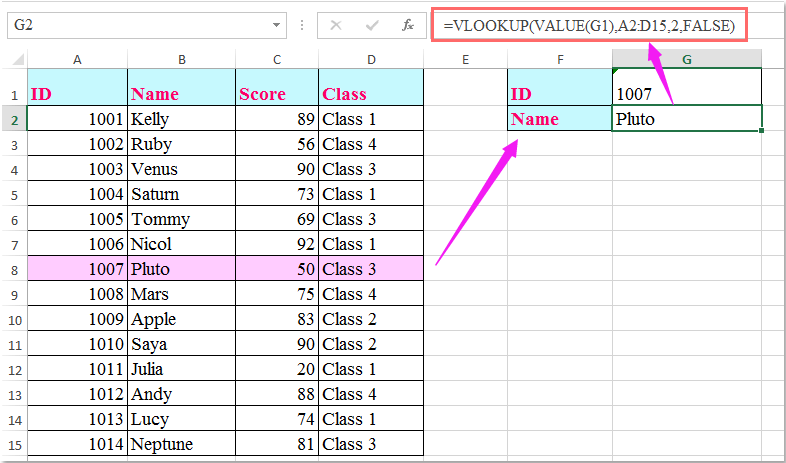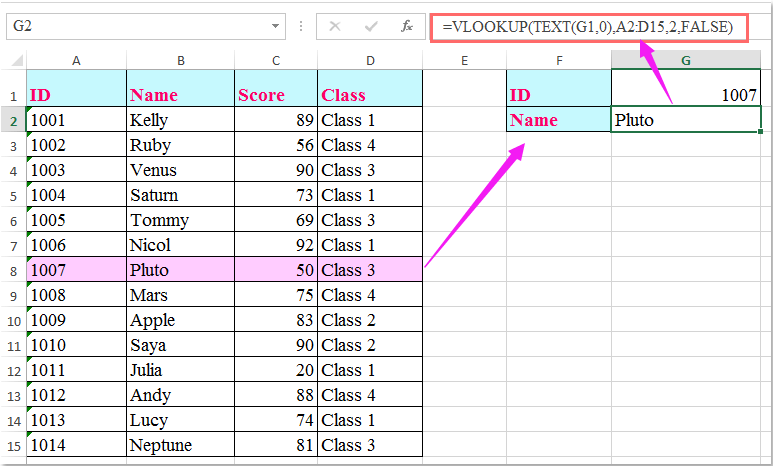एक्सेल में टेक्स्ट के रूप में संग्रहीत संख्याओं को कैसे देखें?
मान लीजिए, मेरे पास निम्नलिखित डेटा रेंज है, मूल तालिका में आईडी नंबर संख्या प्रारूप है, लुकअप सेल में जो टेक्स्ट के रूप में संग्रहीत है, जब मैं सामान्य वीलुकअप फ़ंक्शन लागू करता हूं, तो मुझे नीचे दिखाए गए स्क्रीनशॉट के अनुसार एक त्रुटि परिणाम मिलेगा। इस मामले में, यदि तालिका में लुकअप नंबर और मूल नंबर का डेटा प्रारूप अलग-अलग है तो मुझे सही जानकारी कैसे मिल सकती है?
Vlookup नंबर सूत्रों के साथ पाठ के रूप में संग्रहीत

 Vlookup नंबर सूत्रों के साथ पाठ के रूप में संग्रहीत
Vlookup नंबर सूत्रों के साथ पाठ के रूप में संग्रहीत
यदि आपका लुकअप नंबर टेक्स्ट के रूप में संग्रहीत है, और तालिका में मूल संख्या वास्तविक संख्या प्रारूप है, तो कृपया सही परिणाम देने के लिए निम्नलिखित सूत्र लागू करें:
यह सूत्र दर्ज करें: =VLOOKUP(मान(G1),A2:D15,2,गलत) एक रिक्त कक्ष में जहाँ आप परिणाम ढूँढ़ना चाहते हैं, दबाएँ दर्ज आपको आवश्यक संबंधित जानकारी वापस करने के लिए कुंजी, स्क्रीनशॉट देखें:

टिप्पणियाँ:
1. उपरोक्त सूत्र में: G1 वह मानदंड है जिसे आप देखना चाहते हैं, ए2:डी15 वह तालिका श्रेणी है जिसमें वह डेटा होता है जिसका आप उपयोग करना चाहते हैं, और संख्या 2 उस कॉलम संख्या को इंगित करता है जिसमें वह मान है जिसे आप वापस करना चाहते हैं।
2. यदि आपका लुकअप मान संख्या प्रारूप है, और मूल तालिका में आईडी नंबर टेक्स्ट के रूप में संग्रहीत है, तो उपरोक्त सूत्र काम नहीं करेगा, आपको यह सूत्र लागू करना चाहिए: =VLOOKUP(पाठ(G1,0),A2:D15,2,गलत) आपकी आवश्यकता के अनुसार सही परिणाम प्राप्त करने के लिए।

3. यदि आप निश्चित नहीं हैं कि आपके पास संख्याएँ कब होंगी और आपके पास पाठ कब होगा, तो आप इस सूत्र का उपयोग कर सकते हैं: =IFERROR(VLOOKUP(VALUE(G1),A2:D15,2,0),VLOOKUP(TEXT(G1,0),A2:D15,2,0)) दोनों मामलों को संभालने के लिए.
सर्वोत्तम कार्यालय उत्पादकता उपकरण
एक्सेल के लिए कुटूल के साथ अपने एक्सेल कौशल को सुपरचार्ज करें, और पहले जैसी दक्षता का अनुभव करें। एक्सेल के लिए कुटूल उत्पादकता बढ़ाने और समय बचाने के लिए 300 से अधिक उन्नत सुविधाएँ प्रदान करता है। वह सुविधा प्राप्त करने के लिए यहां क्लिक करें जिसकी आपको सबसे अधिक आवश्यकता है...

ऑफिस टैब ऑफिस में टैब्ड इंटरफ़ेस लाता है, और आपके काम को बहुत आसान बनाता है
- Word, Excel, PowerPoint में टैब्ड संपादन और रीडिंग सक्षम करें, प्रकाशक, एक्सेस, विसियो और प्रोजेक्ट।
- नई विंडो के बजाय एक ही विंडो के नए टैब में एकाधिक दस्तावेज़ खोलें और बनाएं।
- आपकी उत्पादकता 50% बढ़ जाती है, और आपके लिए हर दिन सैकड़ों माउस क्लिक कम हो जाते हैं!
